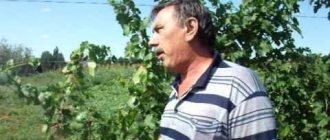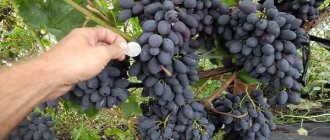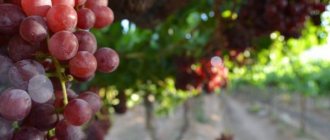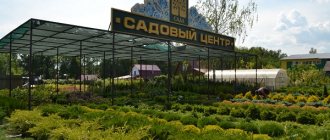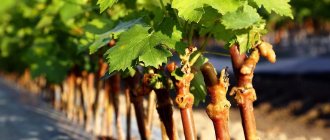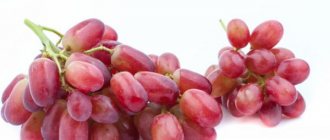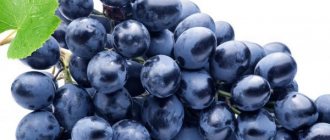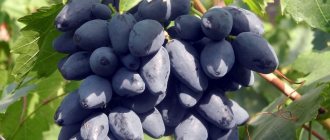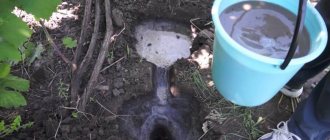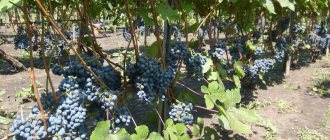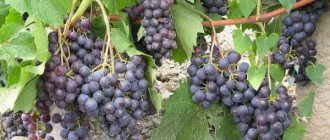One can only sympathize with gardeners and summer residents from the northern regions of Russia: they have to invest much more effort and time into the future harvest. But the most difficult thing is to find a suitable variety that can survive in the difficult climate of the North. This applies to a greater extent to fruits and berries, especially heat-loving ones like grapes. A godsend for summer residents and winegrowers from cold regions is the Taiga variety. These grapes ripen very quickly, practically do not get sick and, most importantly, tolerate low temperatures well.
This article provides a complete description of the Taiga grape variety, with photos and reviews from real gardeners. Beginning winegrowers will be able to learn how to plant cuttings and how to subsequently care for an adult vine.
Description and characteristics of grapes
Before planting a crop in your garden plot, you should familiarize yourself with its key characteristics.
Bushes
This variety is characterized by tall bushes, which are characterized by vine growth of 5-7 meters per year. There are 3 clusters on each shoot. With adequate care and proper pruning, you can get up to 100 kilograms of grapes per year.
Bunches
This plant is characterized by small clusters. Their weight does not exceed 200-400 grams. The fruits are round in shape and weigh 4 grams.
The berries have a pleasant sour taste.
Productivity
The yield parameters are quite high. With strict implementation of agrotechnical measures, it is possible to obtain up to 100 kilograms of berries from a bush. Such indicators can be achieved 7-8 years after planting.
Maturation period
The grapes of this variety are characterized by an extremely early ripening period. This allows the crop to be planted even in regions with harsh climatic conditions. On average, 90-95 days pass from the beginning of the growing season to harvesting. In areas with a temperate climate, it will be possible to get the first fruits at the end of summer.
Winter hardiness
The berries may well remain on the bushes until frost. They will not rot even under autumn rains. This variety is considered very resistant to low temperatures. It can withstand temperatures down to -32 degrees.
See also
Description and characteristics of the Kishmish grape variety Century, cultivation and careRead
Technical features of landing
The description of this variety should begin with the fact that this very tasty and sweet sultana comes from America.
Seedless grapes that ripen early - every gardener would love to have this variety on their plot. However, this black vine is a rather capricious plant, so growing it requires a lot of effort and good care. The harvest from such varietal grapes is harvested in the second or third ten days of July. Its sweet seedless fruits are usually consumed fresh; liqueurs and all kinds of desserts are prepared from the berries of this grape. However, it should be transported and stored with care so as not to damage the delicate fruits.
- The growth of the bushes is distinguished by great vigor, the flowers are bisexual.
- The clusters are cone-shaped, small, weighing up to 600 g.
- The color of sultanas is dark blue, almost black (which is why it got its name), the weight of one fruit is up to 5 g with juicy pulp. The skin of the berries, although not thick, is durable, but when eaten it is practically not felt.
- The foliage of the vineyard is round, large, and green. The vines are brown and strong.
This variety was bred in California by breeders specifically as an early type of sultana that was frost-resistant. It came to our country from Ukraine, where it was grown both on collective farm fields and on personal plots. The most suitable regions of our country for the normal cultivation of Black Emerald are the Lugansk region and the Black Sea coast.
Black sultana has moderate resistance to major fungal diseases (mildew and podium), and is quite resistant to frost (down to -22°C). When caring for Black Emerald, you should use the same basic agricultural techniques as for other grape varieties. However, it is necessary to ensure that during the ripening of the crop there is no overload of the bushes.
Grapes Kishmish Black Emerald
Any agrotechnical measures are carried out when at least half of the brushes of this variety bloom. Carrying them out earlier leads to shedding of the ovaries.
The Black Emerald variety is very sensitive to frost in the spring. Heavy rains or watering can lead to severe cracking of ripening fruits, they may even fall off. It is not highly resistant to aphids. Birds, bees and wasps show increased interest in this grape. Therefore, usually during the ripening period the bunches are packaged in special mesh bags.
This variety is saved from the main diseases of grapes - mildew and podium - by regular preventive spraying with copper sulfate; fungicidal preparations such as Karbofos, Ridomil and other similar products are also used.
Phylloxera is usually treated with carbon disulfide preparations, otherwise this disease will completely destroy the bush in a short time.
This black variety of sultanas is still worth planting on your site, despite some of its capriciousness. And with proper care, good harvests will not keep you waiting.
It's no secret that grapes have moved far to the north. Breeding innovations make it possible to obtain a tasty and productive product in all climatic zones. However, people are surprisingly persistent in trying to preserve what they gained in the last century. Is the old Tayozhny really that good?
Simple taste and viscous aftertaste. Frost-resistant variety of early ripening. Powerful bush with strong shoot growth.
The variety has no information about its “birth”.
There is information that the south of the Primorsky region is the “promised land” for the variety, and then, thanks to its merits, it spread throughout the country. Perhaps at one time it was of value, but it did not pass variety testing and was not included in the register of breeding achievements of the Russian Federation.
Despite this, there are still enthusiasts who continue to grow these grapes and share their experience.
Peculiarities
Taiga grapes are characterized by functionally female flowers, which in the absence of another variety leads to deterioration in fruit set.
Early ripening variety. At a latitude of 54 degrees, ripening takes place over 90 days. This fact captivates novice winegrowers, and they plant cuttings.
This variety is universal. Its berries are suitable both for dessert and for making wine, liqueur, compote, and jam. The taste of this product is a completely different matter.
The high content of pectin substances allows the berries of this grape to be used as an additive for preparing pastes, marmalade, and marshmallows for other vegetables and fruits.
The color of this grape is also used to give rich tones to the products.
Description of the form
Sharing their observations, winegrowers say that “Taiga” has great growth vigor and produces quite powerful bushes during the season.
The length of the Taezhny vine is limited only by pruning; in four seasons, the branches of this variety easily outgrow the five-meter mark.
- The ripening of shoots is greatly influenced by climatic conditions, but timely minting significantly accelerates the ripening process of shoots.
- The grapes take root very well. Almost all cuttings become seedlings.
- Planted seedlings quickly grow and produce not thick, but very long vines.
Bunches and berries
The difference between the clusters of this variety is that they are extremely uniform in shape and size.
Medium-sized bunch of Taiga grapes.
- Conical, loose clusters have an average weight of 250 to 350 g. Since the yield load is not large, up to three clusters are left per shoot and, therefore, it bears up to a kilogram of berries.
- The berry has an even, round shape weighing up to 4 g. The color is dark blue when fully ripe, almost black.
- The taste of the berries is simple and not aromatic, but given the place where they are grown, they are a valuable vitamin product. If the winegrower is lucky and there is not a lot of rainfall, then you can catch a light muscatel aroma. Many winegrowers claim that the words “muscat” and “Taiga” are incompatible, and in their region it never had such an aroma.
- The abundance of pectin substances adds an astringent taste to the variety, especially when chewing the skin. Some tasters believe that such grapes cannot be classified as universal, since the berries are completely tasteless and cannot be used as a dessert.
- The opinions of winegrowers are divided on how the berries are preserved on the bushes.
- Some argue that the berries hang on the vines for a long time and do not lose their marketability. Those who were unlucky and nature gave an abundance of rain claim that this variety is a leader in cracking.
- Among winegrowers there are also statements that the bunches weigh well within 2 months. At the same time, they are washed by autumn rains and frozen, but remain edible and retain their overall integrity.
- There is also an opinion that these grapes weigh on the bushes for a long time and are often covered with snow only because such a berry is good for nothing.
Productivity
Reviews from winegrowers indicate a very high yield of the variety. There is evidence that the record for a grape bush is 112 kg.
An eight-year-old grape bush can produce about a hundredweight of ripe berries in the conditions of central Russia.
- Winegrowers share information that fruiting begins in the fourth year and amounts to about 3 kg.
- Already in the fifth year the yield is 15 kg, the sixth - 20 kg, the seventh - 60 kg, the eighth - 100 kg.
- Describing the harvest, the winegrower shared information that this bush has great growth power and is formed on an arbor.
The fact that climatic features also influence yield is, of course, a determining factor. That is why even northern regions may have yields significantly different from those described in the article.
Read more: Pintail duck description and features of the barnacle bird habitat red book interesting facts
Bush formation
The power of the bush will impress any winegrower. He strives with all his might to conquer territories and give away his harvest.
This grape variety is often used for decorative purposes, covering the walls of buildings with it.
Describing their bushes, winegrowers say that a sleeve of 8 m is absolutely not the limit. By spreading two in each direction, the vineyard can cover a fairly large area.
Often, amateurs shape this variety so that it covers entire walls of the house and reaches balconies and attics. This task is completely feasible.
Many experienced winegrowers believe that this variety is intended precisely for such a decorative purpose.
The enormous growth power captivates those gardeners who choose the variety for the sake of landscaping their estate. By planting bushes from these grapes, it is easy to form green rooms on the site and carry out work to limit and demarcate the space.
When planting this variety, it is necessary to take into account that limiting its growth later will be very problematic. Therefore, if behind it there is something that needs sunlight and ventilation, then it is better to refuse planting.
There are legends about the variety's resistance to fungal diseases and frost. However, not all reviews are so optimistic.
Some winegrowers give examples of grapes being affected by oidium along with other varieties. Others say that this is the most resistant variety to fungal diseases.
What all gardeners agreed on was its resistance to low temperatures.
Shelter for the winter
One of the options for covering grapes for the winter.
Some winegrowers lower the lashes to the ground and try to somehow cover them. Others do not take any measures at all to cover them and the grapes winter well from year to year.
According to those who have been growing this variety for decades, the grapes tolerate temperatures as low as minus 30°C.
Wintering Taiga grapes in the Saratov region. Taiga in Chelyabinsk after wintering under the snow.
There is another variety with the first word taiga - “Taiga emerald”. Often, winegrowers are confused about whether they are the same variety or different ones.
“Taiga Emerald” is a variety bred by Nikolai Tikhonov and it differs from “Taiga” and has a light green berry. However, many publications, without understanding the characteristics, do not bother to look for differences and mislead people.
In addition, there are many grapes similar to this variety. Sooner or later, clarifications begin to arise about “this one” or not “that one.” This situation is difficult to understand. But, in any case, the answer is the same - if you like it, grow it and use it, if not - uproot it and plant it with promising, good varieties.
Advantages of the variety
- The color of sultanas is dark blue, almost black (which is why it got its name), the weight of one fruit is up to 5 g with juicy pulp. The skin of the berries, although not thick, is durable, but when eaten it is practically not felt.
- The fruits are medium-sized, round, green in color, transparent when ripe with a waxy coating, with fleshy pulp.
- The percentage of sugar content in fruits is up to 20%.
- The yield of bushes is quite high and increases with regular application of mineral and organic fertilizers to the soil.
Varietal grape Bashkir emerald
This variety is quite resistant to diseases and pests, however, preventive treatments against mildew and podium should be carried out regularly. In addition to fungicides, bacteriological preparations should be used to prevent diseases and pest attacks during the ripening period of berries.
The main advantages of this variety are very early ripening, high yields from the vine, and good winter hardiness. The Bashkir variety of this grape is recommended for planting in the Ural region.
Main positive and negative aspects
This variety is very popular among gardeners who live in the center and northern regions of Russia. It has many advantages:
- excellent resistance to frost;
- rapid development of the bush;
- high yield parameters;
- available methods of reproduction;
- nutmeg notes in the taste of the fruit;
- early maturation;
- resistance to fungi and other types of infections.
An indisputable advantage of culture is its unpretentiousness to living conditions. The plant can be planted in areas with different climates. It can be planted in almost any soil.
The Taiga variety has no serious disadvantages. At the same time, experienced gardeners note that it has a normal taste. That’s why grapes are often used for processing. However, many people also use it fresh to replenish vitamin deficiencies.
History of origin
The taiga emerald was bred in the Far Eastern region through amateur selection, but by a very famous scientist - professional and candidate of science, Nikolai Tikhonov. Nikolai devoted his entire life to grapes, creating more than 20 new varieties; he was one of the students of the world-famous Ivan Michurin. When the taiga emerald became one of the results of his work in 1958, this form quickly gained popularity and became one of the most famous in Primorye and throughout Russia.
The basis for its creation was a self-pollinated seedling of the American species Minnesota, which is why it is also often called Minnesota seedling or Tikhonov No. 9. It has become widespread in all regions with cold climates.
Cultivation
To achieve success in growing crops and phenomenal yields, it is necessary to pay attention to planting work.
Landing dates
It is recommended to plant the crop in the ground in the spring. Carrying out planting work in autumn is permissible only in areas with warm winters.
Selecting a location
The bush should be planted on the south side of the site, which warms up well. It is important that the plant is not exposed to drafts. During planting work, it is worth placing a trellis or poles near the bush. This will ensure normal development and good branching of the culture.
Seedling preparation
When purchasing a seedling, you should carefully examine its condition. It is important that the plant meets the following criteria:
- It had a powerful root system with many thread-like fragments.
- It had a light brown tint to the roots on sections.
- Had a balanced ratio of top and bottom. This means that the root system must correspond to the size of the above-ground part of the plant.
- It was distinguished by smooth leaf plates. They should not be deformed or have yellow tips.
Before planting a bush in open ground, it is recommended to soak it in water or use a growth stimulator.
Site preparation and planting
To plant this plant you will need a hole measuring 100x100 centimeters. It is worth adding 20 centimeters of sand or crushed stone, 12 centimeters of a composition based on sawdust and crushed bricks to the pit. Then you should use the heated soil from the recess. It is recommended to mix it with humus and wood ash. You can add a glass of oats to the composition.
It is recommended to cover the recess with black film for a day. This helps warm the soil. 2 hours before planting, the seedling should be taken outside so that it adapts to the climate.
See also
Description and characteristics of the Lilac Fog grape variety, care rulesRead
Then make a 40-centimeter depression in the hole and place the seedling in the center. Level the root system and sprinkle the plant with soil. Place a support and water with warm water. Finally, mulch the tree trunk with fallen leaves or sawdust.
Forum statistics
207036 Messages in 1634 Topics from 5593 Users. Last user: Amaya Last message: “Let's talk about the weather in Vash...” ( Today at 07:52:22 ) Latest messages on the forum.
Now on the forum
37 Guests, 11 Users
Users in the last 15 minutes: Yura, 64nikolay64, zsb, GALINA ANOKHINA, Polina77, spotlight, Mikhail Alekseevich, Svetla777, Tihiy, Marshal, Nikolay S. [Blocked] [Section Moderator] [Forum Moderator]
Maximum online today: 77 . All-time maximum online: 2758 (28 July 2021, 17:22:51)
Users who visited the forum in the last 24 hours
Total: 293
(Visible: 292, Hidden: 1) 1963, Yura, 64nikolay64, zsb, GALINA ANOKHINA, Polina77, spotlight, Mikhail Alekseevich, Svetla777, Quiet, Marshal, Nikolay S., therapist, Liza, Capricorn, lomakin1969, Alexander Vl., Elvira2017 , Andrey76, Slavka, Mikhail77, ElenkaF, Tatyana B, Alex65, Cherkessk, Eugene, leonidych, vladimirM, yotmast, mers, Serg1707, SNovichek, hanter64, znakomij, Alexander K, Vardan, Sergey Fer, Anatoly Sivkov, Alexey V, Ilya 77 , Andrey Gladilin, Tatyana A., Belgorodets, in Astrakhan, Oksana Kopp, sem_en, Vladimir 153, skier, Igor Viktorovich, slavalimon, Primorets, OlgaOs, SANYCH, 31rus, mystic69, DorontsovPeter, Andrey Tsvetkov, Buba, igor222, Elena Z, vlad51, Kenig, Nikolay Rex, Sergey 1965, Vladimir Buturlakin, DSW, psv1960, Dmitry 77, Vasily V., Vyacheslav03, Natalia Nikolaevna, Sergey Tashchiyan, Igor Sergeevich, alexsandr, kvg, Pioneer, Ekaterina Polyanina, nicson7, Elena Aleshchenko, Alexander -ask-34, Verona, Igor F., Taker, Henry, Yuri72, L.A.P., Gaivoronsky Yuri, Sergeevich, Sergei Chistokletov, Svetlana Streletskaya, Galinka, Alexey Deminov, Naumov Igor, Vyacheslav136, Gloomy, Katrin, AndSanych , Mikhno Alexander, Ded31, Filippov Oleg, Vladimir ++, Lydia58, ALEXANDER BRYANSKY, Vladimir-kanevskaya, DIL, Amber7394, Marina Protasova, TITOVA LYUBOV, Linx, alexander66, Natalya M, Mikhail Fesenko, Amaya, Alexander71, Boris 1952, tsv , Maximilian, 25nata35, nadia, Igor_K, Alexander Kolesnikov, Ivan Levin, Pitko, weather forecaster, eSAa, cecet71, atseton, Alexander Smirnov, Vladimir Kostochkin, Vladimir Berdnikov, Gocha, pioneer-2, LeXa_KoT, Sergey 61, Sergey Yuryev, Erem, alexss, Evgeniy52, Skif, Vladimir Kovba, dayton, Yuri Semenov, N.A. Sokolov, Pavlentiy, Sa-shura, Volgogradka, Dmitry Anatolyevich, Grandfather Igor, Andrey Lis, Bublichenko Alexander M, Marina Krymskaya, stenlly2010, irahelm, Vyacheslav Vladimirovich , Vladimir Shilov, Aprel, Dmitry Badaev, gheo55, y_fed, rambo, Yagodka, Valentina Ivanovna, Kryn, oleg9f, DED2, Svetlana Korotina, Oleg Ivanovich Zavezen, Eduard., santra, L2k2m7n, Alexander48, Viknik, Andrey 31, m2d, Valery Rastorguev, Soshnin Yura, Gardener - amateur, Galina, Vasily1111, gardener, marlin64, Salex, sergei, Sergey Ko, Ramiz, Victor_, kosmos, potap05, Yuri 36, VitalySD, Inna161, Vova Kapran, Vladimir Shcherbinin, Valerie, niy1, cfibr , Andrey68, kulol3, thanatos, Serzh1978, Realist, Artur53, max2008-01, LOZA, AlexanderD, Grandfather Young, Natasha, Zayac, ketch, Rita, alx-74, Iv Iv, Alexander150, Igor K, Vasily Viktorovich, VeraNiK, kdm57 , Veniaminovich, Boris Sokolyansky, 77volt, , vikbublik, neposny, Evgen, Victoria Aleksandrovna, Serezha 64, Wintel, Airbone, teri, Sergey Lomonosov, Khramov, serginio, Leonty Yarygin, Irina O., Ser, Nadezhda Grig, Lyubov S., netolya, Saisan, Alexey Agryzkov, Vadi, Zinaida, Vadim, Alexander Taganrog, Sergey Sukhonos, Snezhinets, evgen_26, nau_63, Masha_sadovod, Gennady163, krasnovlad1, Alexander Zinoviev, Vasily 53, Roman Fedorovich, TIS, Alexey Sergeevich, arnyusha, Zheka, Nurtas , kradievska, nick041, Valentina Medvedeva, Sergey43, Andrey S., Nikolay Lipunov, Mst, Vertuoz2, Vladimir VS, NatalyaMed, freesia, Kinna, Mikhail Michurinsk, alekcsan1, VALERY TAMB, Sasha57, MikhAf, Y_Azer, Andrey Beribesov, hunter1955, amateur nuts, Keys, Ivan Shmelev, Pestle, anton_slash, Nadymchanka, Sergey 31, Volgar, Pavel 64, Tatyana Volzh, Elektronik_t, Alexander 61, Alexander Gai
Variety care
In order for grapes of this variety to have high yields and rapid growth, they need to be provided with adequate care.
Watering
In the first year after planting, it is recommended to water the seedling every other day. If the climate is quite humid, the number of waterings is reduced to once a week. In the second year, the plant is watered in hot weather once a week.
If precipitation is observed, there is no need to moisten the soil.
Fertilizers
It is recommended to feed the crop twice a year. In the fall, it is worth adding organic compounds. Bird droppings, humus, and compost are suitable for this. In spring it is recommended to use minerals. To do this, for 10 liters of water you can take 20 grams of superphosphate, 10 grams of ammonium nitrate and 5 grams of potassium salt.
Bush formation
It is recommended to prune the plant in spring. During the procedure, it is worth removing dry branches and bunches. The procedure is not carried out in the fall. In severe frosts, this will lead to freezing of the shoots.
Shelter for the winter
When growing a crop in a region with a harsh climate, it must be covered. To do this, perform the following actions:
- Plywood is placed on the ground near the plant.
- Remove the vine from the support, tie it up and carefully place it on the flooring.
- Cover the plant with a tarpaulin or spruce branches. Dry soil is poured on top.
When snow falls, you should throw a large snowdrift on the bush. Thanks to this, the plant will easily overwinter, and its root system will not freeze.
Reviews
Valentina Sergeevna, Bryansk:
Although I don’t live in the north, I don’t live in the southern regions either. We rarely grow grapes - few varieties bear fruit in cool climates. Well, at my neighbors’ dacha I saw the Taiga variety with black berries. I became interested and learned how to grow it. And here is the result - there are already three bushes of this grape growing on my plot.
I am completely satisfied: the vine does not freeze in winter, is very stable, bears fruit well and early. The berries have a wonderful taste; you can eat them fresh and prepare them for the winter.
In Siberia, most summer residents do not even dream of growing grapes. If it weren’t for the “Taiga” variety, I wouldn’t have dreamed of it either. But this variety completely changed my ideas about grapes, about a southern, heat-loving culture.
Agrobiological properties
The bushes have high growth energy, abundantly grow vegetative mass and have a deep root system. The shoots are powerful and very long. The leaves are medium and large, round in shape, consisting of three, less often five, lobes, the dissection between which is low. The upper side of the leaf blade is finely bubbly, dark green with slightly lighter veins. The pubescence on the back side is not noticeable. The leaf profile is funnel-shaped, but the edges of the blades are often drooping. The upper lateral notches are of medium depth, open, most often V-shaped, sometimes lyre-shaped with a rounded bottom. The lower cutouts are barely outlined or absent. Many leaves can grow without cutting at all. The petiole recess is vaulted or lancet in shape. The petioles are long and thin, green in color, rarely with a faint anthocyanin tint. The denticles along the perimeter of the leaf blade are small, triangular, with sharp tops and straight sides. The flowers are functionally female, which suggests an insufficient level of pollination. However, Taiga refutes this popular stereotype, showing excellent fruit set, provided that there are bisexual varieties nearby that bloom at the same time. Annual shoots ripen well, acquiring a brownish-brown color in the process.
The bunch of Taiga grapes is medium in size, loose in structure and cylindrical-conical in shape. The usual weight of a standard brush is about 150 grams. The largest ones can reach 250 g. Thanks to the free arrangement, the berries are not damaged by each other and are not deformed. The comb is quite long, green, and not woody. The berries are small, round, about 16 mm in diameter, black or dark blue in color, covered on the outside with a layer of bluish prune coating. The weight of one hundred grapes is 250 - 350 grams. The pulp of the fruit is quite tender and juicy, the taste is balanced - sweet and sour; according to some evidence, light nutmeg tones can be detected in the aroma. The sugar content in the squeezed juice is high - up to 20g/100 ml, but the sweetness in the taste is offset by noticeable acidity. The berries also contain a significant amount of pectin. The skin of the grapes is eaten. There are bones, up to three in number. The taste is average, which is quite forgivable for an unpretentious northern variety.
The harvested crop can be used either directly for food or processed into compotes, preserves, and jams that are wonderful in gastronomic terms and very rich in color. Rich in vitamins and minerals, these preparations will come in handy in winter. In addition, many owners make dry red homemade wine from Taiga. It turns out to be quite good in quality, which is facilitated by a successful balance of sugar and acid in the wort. Due to the sufficient level of alcohol, the finished drink is shelf stable. The aroma of this wine is very fragrant and unique in its own way. Some gourmets, however, notice so-called “labrusque” tones in the bouquet, which they consider unpleasant to their perception. However, most winegrowers do not pay attention to this.
“Snow Beauty” Chionodoxa: planting and care in open ground, tips for growing an early perennial with original flowers in the form of multi-colored stars
The ripening of grapes occurs at a very early stage. For the Primorsky hero, only 90 - 92 days after bud break in the spring are enough to reach technical ripeness. The sum of active temperatures during this time does not exceed 2000 °C, which allows Taiga to ripen in the north of the European part of our country, in many regions of the Urals and Siberia. An additional advantage here is the amazing frost resistance of the vine, reaching −35…−40 °C. It allows you to cultivate plants without shelter even in the harshest conditions, where southern varieties would hardly survive the winter even with insulation.
The yield of the variety is very high, thanks to the gigantic dimensions of adult bushes, as well as a significant number of inflorescences formed on the shoots. Thus, the fruiting rate can reach 2.5 - 3.5 clusters per vine, and a limitation on their number is not required due to the fantastic vital energy of the plants. As a result, by the seventh or eighth year after planting, you can get up to 100 kg of grapes from each bush without signs of overload. After ripening, the bunches can continue to hang freely on the vine until frost. The berries are not prone to cracking or rotting, so even heavy rains and sudden changes in soil moisture cannot harm them.
